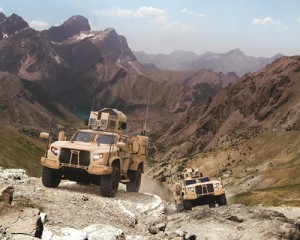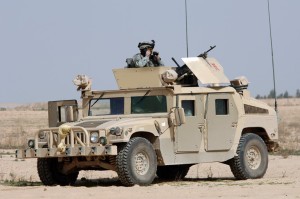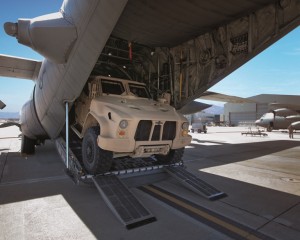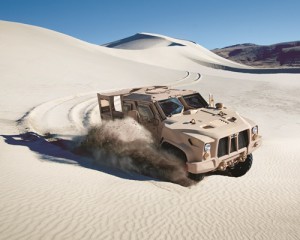For three decades the High Mobility Multipurpose Wheeled Vehicle (HMMWV) commonly called the Humvee has been the mainstay of the United State military’s light utility vehicle needs. The U.S. Army, however, is now in the process of replacing the popular vehicle with Oshkosh Defence’s Light Combat Tactical All-Terrain Vehicle (L-ATV).
Replacing the Jeep in 1984, the Humvee proved itself on the field but as the U.S. military got more deeply involved in a series of conflicts in the Middle East, the vehicle proved to be no match to improvised explosive devices (IEDs) favoured by enemy forces in the Iraq War. As casualties mounted, the idea of a Joint Light Tactical Vehicle (JLTV) emerged in 2007. By August 2015, the Army announced the Oshkosh L-ATV as the winner of the JLTV program.

Lockheed Martin, one of the contenders in the program, has filed a protest against the decision awarding Oshkosh with the contract to replace the Humvee. However, on Dec. 15, the Government Accountability Office dismissed the protest and Oshkosh is now resuming work to fulfill the $6.75 billion to produce 16,901 vehicles for the Army and Marines.
The unit cost of a base L-ATV comes up to $250,000. Units with radios, weapons and armour cost around $400,000 to $560,000 each depending on the configuration.
By comparison, an up-armoured Humvee costs around $220,000.
Built like a tank runs like a jeep
Tank-like is probably the best word to describe the Oshkosh L-ATV. With a curb weight of 6,400 kg, it is more than twice as heavy as an up-armoured Humvee that weighs in at 2,676 kg.
The L-ATV will come in two variations, four-passenger combat vehicles and two-seat combat support vehicles. The L-ATV carries a maximum weight of 7093 kg, one-third less than the M-ATV and light enough to be transported by a helicopter.
The L-ATV protects its crew with a system called Core1080 which includes IED detection features, mine resistance capabilities, blast protected seats, automatic fire suppression systems and an integrated system designed to absorb and deflect blast energy. Its armour is classified A-kit and B-kit. It can carry a variety light and medium caliber weapons plus automatic grenade launchers (AGLs) and an anti-tank ground weapon (ATGW) when needed.

Considering the heft all that would account for, the vehicle has the agility of a Baja racer, according to John Bryant, senior vice president of defence programs for Oshkosh. An early development version of the L-ATV actually became the first military class vehicle to compete at the Baja 1000 desert race in 2010.
The vehicle can run up to 482 kilometers between gas ups. The vehicle’s GM Duramax 6.6 litre V8 engine rated at 300 hp, carries the L-ATV to a road speed of up to 112 kph, off road speeds varies.
Hybrid powertrain
One of the factors that make the L-ATV unique is ProPulse diesel-electric hybrid powertrain.
The system enables the vehicle to generate between 30 to 70kW of military-grade power that could be made available both while the vehicle is station and on the move.
“This is particularly important as the military seeks to improve energy efficiency and make forces leaner,” according to Bryant. “Exportable power reduces the need to generators in-theater.”

“The Oshkosh TAK-4i intelligent independent suspension system is lighter and provides 25 per cent more wheel travel than today’s gold standard, the TAK4. The TAK-4i uses advanced shock absorbers and that can be raised and lowered using interior controls and it incorporates disc brakes,” Bryant told Vanguard Magazine. “It can carry troops at off-road speeds that are 70 per cent faster than today’s gold standard, which is our own M-ATV.”
The L-ATV share is genes with Oshkosh’s much heavier Mine-Resistant Ambush-Protected All-Terrain Vehicle (M-ATV), which is actually primarily running JLTV missions today because the military considers armoured Humvees and MRAP vehicles to be restricted to roads or the base, according to Bryant.
“An up-armoured HMMWV‘s performance and survivability are not even in the same ballpark as the Oshkosh JLTV,” he said. “An up-armoured HMMWV, with more than 3,500 lbs. of additional payload, loses its off-road mobility and speed, rendering it incapable of meeting mission requirement.”
Bryant foresees the JLATV and Humvee performing different roles within the Army and Marine Corps.
“Now more than 30-years-old, the HMMWV may continue to play its original intended role: transportation of personnel and equipment ‘behind the wire’,” said Bryant. “The HMMWV was designed for light utility and not for use as a front-line combat vehicle.”
C4ISR capabilities
In constructing the L-ATV, Oshkosh took the approach of building in modular C4ISR capabilities from the start. Traditionally built vehicles often tend to get delivered fully-configured making it difficult for customers adjust their vehicles to meet arising mission requirements.

The strategy, according to Bryant, enabled Oshkosh to incorporate “plug-and-play” Command, Control, Communications, Computer, Intelligence and Reconnaissance systems that can be configured at a moment’s notice to fulfill rapidly changing mission requirements as opposed to having a vehicle seat in the garage for days until the needed equipment is installed. The result is a vehicle that provides flexibility and scalability.
The integrated C4 systems of the L-ATV include:
- Command and control – on-the-move battlefield situational awareness systems and global positioning systems (GPS)
- Communications – HF, VHF, UHF, SATCOM and vehicle intercoms
- Computers – centralized computers and smart displays with network integration and software integration
- Electronic warfare – counter radio electronic warfare (CREW) systems
- Surveillance – long-range surveillance systems, shot detection, silent watch power systems, visible light and IR camera systems
- Weapons – turret-operated systems, remote weapons systems (RWS), tube-launched missile systems
“Our L-ATV has a scalable and vertically integrated design that is prepared to be outfitted with any of the latest C4ISR packages our customers require,” said Bryant. “In fact, we delivered 22 different configurations for the EMD phase.”
Will Canada need an L-ATV?
Oshkosh has not received any queries from Canada about the L-ATV; however, Bryant is probably not discounting the possibility of getting a call from DND.
“We understand that the Canadian Forces currently has hundreds of armoured HMMWVs in their fleet, however, The Canadian Special Operations Forces Command (CANSOFCOM) is seeking Next Generation Fighting Vehicles with increase protection and mobility in the near future,” he said.
The NGFV is intended to be a tactical, multi-role vehicle for CANSOFCOM. Preliminary estimates for the NGFV are around $100 million and $249 million. Optional analysis for the project is supposed to be done in 2015, with request for proposals released at around 2017.
“We’re not disclosing the details related to any potential international programs for the L-ATV at, this time,” said Bryant.
Find other engaging content 
in the Dec-Jan 2016 issue of Vanguard Digital. Click here.


